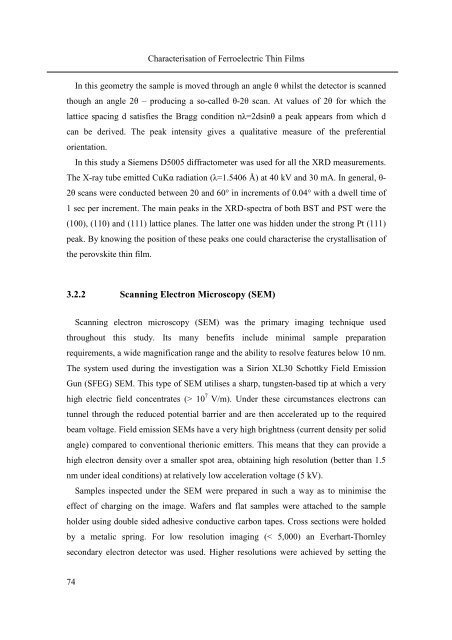PhD Thesis Arne Lüker final version V4 - Cranfield University
PhD Thesis Arne Lüker final version V4 - Cranfield University
PhD Thesis Arne Lüker final version V4 - Cranfield University
Create successful ePaper yourself
Turn your PDF publications into a flip-book with our unique Google optimized e-Paper software.
74<br />
Characterisation of Ferroelectric Thin Films<br />
In this geometry the sample is moved through an angle θ whilst the detector is scanned<br />
though an angle 2θ – producing a so-called θ-2θ scan. At values of 2θ for which the<br />
lattice spacing d satisfies the Bragg condition nλ=2dsinθ a peak appears from which d<br />
can be derived. The peak intensity gives a qualitative measure of the preferential<br />
orientation.<br />
In this study a Siemens D5005 diffractometer was used for all the XRD measurements.<br />
The X-ray tube emitted CuKα radiation (λ=1.5406 Å) at 40 kV and 30 mA. In general, θ-<br />
2θ scans were conducted between 20 and 60° in increments of 0.04° with a dwell time of<br />
1 sec per increment. The main peaks in the XRD-spectra of both BST and PST were the<br />
(100), (110) and (111) lattice planes. The latter one was hidden under the strong Pt (111)<br />
peak. By knowing the position of these peaks one could characterise the crystallisation of<br />
the perovskite thin film.<br />
3.2.2 Scanning Electron Microscopy (SEM)<br />
Scanning electron microscopy (SEM) was the primary imaging technique used<br />
throughout this study. Its many benefits include minimal sample preparation<br />
requirements, a wide magnification range and the ability to resolve features below 10 nm.<br />
The system used during the investigation was a Sirion XL30 Schottky Field Emission<br />
Gun (SFEG) SEM. This type of SEM utilises a sharp, tungsten-based tip at which a very<br />
high electric field concentrates (> 10 7 V/m). Under these circumstances electrons can<br />
tunnel through the reduced potential barrier and are then accelerated up to the required<br />
beam voltage. Field emission SEMs have a very high brightness (current density per solid<br />
angle) compared to conventional therionic emitters. This means that they can provide a<br />
high electron density over a smaller spot area, obtaining high resolution (better than 1.5<br />
nm under ideal conditions) at relatively low acceleration voltage (5 kV).<br />
Samples inspected under the SEM were prepared in such a way as to minimise the<br />
effect of charging on the image. Wafers and flat samples were attached to the sample<br />
holder using double sided adhesive conductive carbon tapes. Cross sections were holded<br />
by a metalic spring. For low resolution imaging (< 5,000) an Everhart-Thornley<br />
secondary electron detector was used. Higher resolutions were achieved by setting the

















